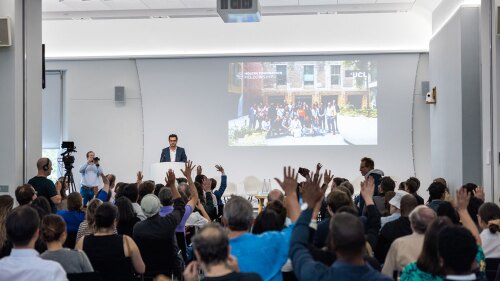ULI’s Global Sustainability Outlook, launched in 2021 by the Randall Lewis Center, has become the organization’s annual barometer on the sustainability topics shaping real estate and land use. Each year, the report distills insights from global industry leaders to identify the top issues most likely to influence strategic decision-making in the year ahead and beyond. The inaugural 2021 report featured 10 key issues, and in subsequent years ULI has refined the focus to the top five. Read past reports here.
From lofty climate goals to gritty regulatory and political realities, the global outlook on sustainability reflects the long-range transformation underway across the wider industry, one that has seen growing skepticism about buzzwords and greater respect for tangible action. So what’s endured, what’s evolved, and what has faded?

This graphic illustrates how the Global Sustainability Outlook themes have evolved, recurred, and shifted over the past five years. Each column lists the top themes from the year’s Global Sustainability Outlook report. Some themes emerged year after year, particularly decarbonization and resilience. Others came up in 2021 and re-emerged later, such as people-centered sustainability, whole-building decarbonization, and energy. Reporting and regulation took the stage in Global Sustainability Outlook reports from 2022-2024, while water slipped below the radar. Read the upcoming 2026 report in January to see what emerges as the top priorities.
(Adam Giordano and Melissa Goodwin)
Evolving toward action
Despite the shifting political and economic landscape, unshakable imperatives have persisted. ESG (environmental, social, governance) might not be name-dropped as often in 2025, but its core pillars still anchor business strategy and risk management—with environmental performance leading the charge. At the center is decarbonization, one of the most pressing dimensions of ESG. While earlier years emphasized setting ambitious net-zero targets and ESG investing, attention around reporting and regulation arose from 2022-2024, by which time simplifying decarbonization became paramount.
The ESG forecast for 2025 predicted an industry focused on simplifying and executing practical solutions. Actionability and scalability became critical—solutions needed to pencil across asset classes, regions, and portfolios if they were meant to meaningfully move the needle toward a sustainable future.
Building materials have also been a focus over the years, first appearing in 2021 and returning in 2025, largely because embodied carbon—the emissions from extracting, manufacturing, and transporting materials—can make up a substantial portion of a building’s total carbon footprint. Between 2021 and 2022, the reports highlighted the importance of tracking and lowering these emissions. Now the focus has intensified, fueled by improved data and growing pressure to reduce scope 3 emissions. This shift highlights a broader perspective: sustainability in buildings now considers the full life cycle, with material choices playing a pivotal role in meeting climate targets.
While decarbonization often sits at the forefront of sustainability goals, it does not stand alone. Cutting operational and embodied emissions is only part of the equation. The sector must also be prepared for the physical risks that climate change brings. Thus, resilience remains an important factor, consistently ranking every year among the top priorities in the Global Sustainability Outlook. From California wildfires to Bangladesh floods, climate disasters have intensified worldwide, and climate risks are no longer abstract projections but pressing realities. To safeguard both buildings and the people inside them, the industry has shifted from simply identifying vulnerabilities to actively developing solutions and exploring how to finance them.
One of the things we are seeing is extreme weather diminishing the resilience of most grids. We are seeing shutdowns because of wind events, for instance. So this is driving a lot of focus on investing in resiliency. Suddenly, energy storage is becoming a very real issue. But every location faces its own specific risks and opportunities. A granular analysis is necessary to assess the best course of action to bolster resilience globally.
Since 2021, people-centric sustainability has remained a primary focus, but the conversation has evolved. Beyond tenant satisfaction and productivity, the emphasis now rests on holistic health and human-centered design, recognizing that comfort, mental wellness, and air quality are not luxuries but essentials.
Shifting trends, enduring importance
That same approach extends to social equity. While equity was highlighted as a standalone theme in 2021, recent reports increasingly weave it into the industry’s broader strategies on sustainability. These global priorities must ultimately be realized at the local level, addressing the needs of marginalized communities, particularly in the Global South, who face the greatest physical and transition risks despite contributing the least to global emissions.
Other topics that once held the spotlight have also seen a shift in how they are addressed. Water, a theme in 2021, has received less explicit attention in recent reports, likely because it has required less ongoing investment compared to decarbonization, flood mitigation, and the like.
Grid-interactivity drew attention in 2021 as a potential driver of energy efficiency and resilience but has not yet been deployed at-scale globally. Its presence in recent discussions has become part of broader conversations around responding to increasingly volatile energy prices, with a growing emphasis on sourcing and storing green power in 2025. Notably, new technologies continue to gain traction. The rise of AI and the subsequent growth of data centers has positioned digital infrastructure and grid considerations as critical future considerations.
Collaboration was a key theme in 2023. From tenant engagement to climate resilience, collaboration is embedded across topics even when it does not appear as a distinct trend. This evolution reflects a maturing understanding of collaboration as a foundational competency rather than a discrete initiative. Many experts continue to underscore the importance of cross-stakeholder partnerships in achieving meaningful impact, highlighting collaboration as ongoing and necessary.
We are just getting started. This is our opportunity to align capital, create partnerships, and cross-market relationships to enable innovation to keep moving forward.
Looking ahead
Collectively, these shifts illustrate how some aspects of sustainability have evolved to become established elements of real estate practice, while newer strategies are still being worked out.
It’s clear that the industry is shifting from aspiration to action, with a sharper focus on practical solutions that can scale. Looking ahead, ULI is eager to see what themes will define the Global Sustainability Outlook 2026, which is due to be released in January 2026. Will new technologies, policies, or market forces take center stage? Or will enduring challenges such as decarbonization and resilience continue to dominate? Stay tuned for the report and ULI’s launch webinars in early 2026.






